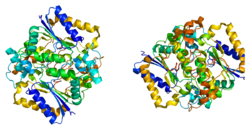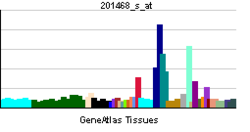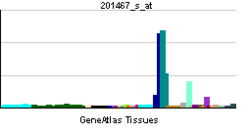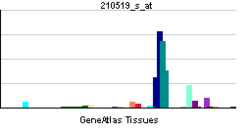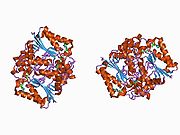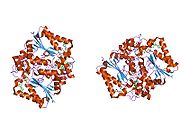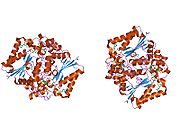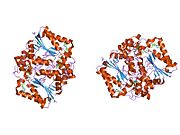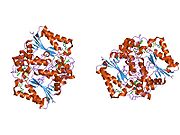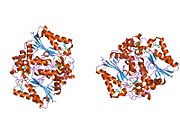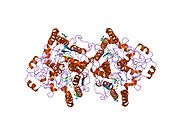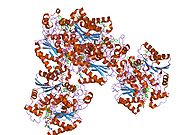- NAD(P)H dehydrogenase (quinone 1)
-
NAD(P)H dehydrogenase [quinone] 1 is an enzyme that in humans is encoded by the NQO1 gene.[1]
This gene is a member of the NAD(P)H dehydrogenase (quinone) family and encodes a cytoplasmic 2-electron reductase. This FAD-binding protein forms homodimers and reduces quinones to hydroquinones. This protein's enzymatic activity prevents the one electron reduction of quinones that results in the production of radical species. Mutations in this gene have been associated with tardive dyskinesia (TD), an increased risk of hematotoxicity after exposure to benzene, and susceptibility to various forms of cancer. Altered expression of this protein has been seen in many tumors and is also associated with Alzheimer's disease (AD). Alternate transcriptional splice variants, encoding different isoforms, have been characterized.[2] Recent pharmacological research suggests feasibility of genotype-directed redox chemotherapeutic intervention targeting NQO1*2 breast cancer, a common missense genotype encoding a functionally impaired NQO1 protein. [3]
Interactions
NAD(P)H dehydrogenase (quinone 1) has been shown to interact with HSPA4.[4]
References
- ^ Jaiswal AK, McBride OW, Adesnik M, Nebert DW (October 1988). "Human dioxin-inducible cytosolic NAD(P)H:menadione oxidoreductase. cDNA sequence and localization of gene to chromosome 16". J Biol Chem 263 (27): 13572–8. PMID 2843525.
- ^ "Entrez Gene: NQO1 NAD(P)H dehydrogenase, quinone 1". http://www.ncbi.nlm.nih.gov/sites/entrez?Db=gene&Cmd=ShowDetailView&TermToSearch=1728.
- ^ Cabello CM, Lamore SD, Bair WB, Davis AL, Azimian SM, Wondrak GT (November [Epub ahead of print] 2010). "DCPIP (2,6-dichlorophenolindophenol) as a genotype-directed redox chemotherapeutic targeting NQO1*2 breast carcinoma.". Free Radic Res. 45 (3): 276–292. doi:10.3109/10715762.2010.526766. PMID 21034357. http://www.ncbi.nlm.nih.gov/pubmed/21034357.
- ^ Anwar, Adil; Siegel David, Kepa Jadwiga K, Ross David (April 2002). "Interaction of the molecular chaperone Hsp70 with human NAD(P)H:quinone oxidoreductase 1". J. Biol. Chem. (United States) 277 (16): 14060–7. doi:10.1074/jbc.M111576200. ISSN 0021-9258. PMID 11821413.
Further reading
- Vasiliou V, Ross D, Nebert DW (2006). "Update of the NAD(P)H:quinone oxidoreductase (NQO) gene family". Hum. Genomics 2 (5): 329–35. PMID 16595077.
- Li Y, Jaiswal AK (1992). "Regulation of human NAD(P)H:quinone oxidoreductase gene. Role of AP1 binding site contained within human antioxidant response element". J. Biol. Chem. 267 (21): 15097–104. PMID 1340765.
- Jaiswal AK (1991). "Human NAD(P)H:quinone oxidoreductase (NQO1) gene structure and induction by dioxin". Biochemistry 30 (44): 10647–53. doi:10.1021/bi00108a007. PMID 1657151.
- Traver RD, Horikoshi T, Danenberg KD, et al. (1992). "NAD(P)H:quinone oxidoreductase gene expression in human colon carcinoma cells: characterization of a mutation which modulates DT-diaphorase activity and mitomycin sensitivity". Cancer Res. 52 (4): 797–802. PMID 1737339.
- Chen LZ, Harris PC, Apostolou S, et al. (1991). "A refined physical map of the long arm of human chromosome 16". Genomics 10 (2): 308–12. doi:10.1016/0888-7543(91)90313-4. PMID 2071140.
- Maruyama K, Sugano S (1994). "Oligo-capping: a simple method to replace the cap structure of eukaryotic mRNAs with oligoribonucleotides". Gene 138 (1–2): 171–4. doi:10.1016/0378-1119(94)90802-8. PMID 8125298.
- Rothman N, Smith MT, Hayes RB, et al. (1997). "Benzene poisoning, a risk factor for hematological malignancy, is associated with the NQO1 609C-->T mutation and rapid fractional excretion of chlorzoxazone". Cancer Res. 57 (14): 2839–42. PMID 9230185.
- Suzuki Y, Yoshitomo-Nakagawa K, Maruyama K, et al. (1997). "Construction and characterization of a full length-enriched and a 5'-end-enriched cDNA library". Gene 200 (1–2): 149–56. doi:10.1016/S0378-1119(97)00411-3. PMID 9373149.
- Smiley JF, Levey AI, Mesulam MM (1998). "Infracortical interstitial cells concurrently expressing m2-muscarinic receptors, acetylcholinesterase and nicotinamide adenine dinucleotide phosphate-diaphorase in the human and monkey cerebral cortex". Neuroscience 84 (3): 755–69. doi:10.1016/S0306-4522(97)00524-1. PMID 9579781.
- Moran JL, Siegel D, Ross D (1999). "A potential mechanism underlying the increased susceptibility of individuals with a polymorphism in NAD(P)H:quinone oxidoreductase 1 (NQO1) to benzene toxicity". Proc. Natl. Acad. Sci. U.S.A. 96 (14): 8150–5. doi:10.1073/pnas.96.14.8150. PMC 22203. PMID 10393963. http://www.pubmedcentral.nih.gov/articlerender.fcgi?tool=pmcentrez&artid=22203.
- Kristiansen OP, Larsen ZM, Johannesen J, et al. (1999). "No linkage of P187S polymorphism in NAD(P)H: quinone oxidoreductase (NQO1/DIA4) and type 1 diabetes in the Danish population. DIEGG and DSGD. Danish IDDM Epidemiology and Genetics Group and The Danish Study Group of Diabetes in Childhood". Hum. Mutat. 14 (1): 67–70. doi:10.1002/(SICI)1098-1004(1999)14:1<67::AID-HUMU8>3.0.CO;2-5. PMID 10447260.
- Eliasson M, Boström M, DePierre JW (1999). "Levels and subcellular distributions of detoxifying enzymes in the ovarian corpus luteum of the pregnant and non-pregnant pig". Biochem. Pharmacol. 58 (8): 1287–92. doi:10.1016/S0006-2952(99)00185-9. PMID 10487530.
- Skelly JV, Sanderson MR, Suter DA, et al. (1999). "Crystal structure of human DT-diaphorase: a model for interaction with the cytotoxic prodrug 5-(aziridin-1-yl)-2,4-dinitrobenzamide (CB1954)". J. Med. Chem. 42 (21): 4325–30. doi:10.1021/jm991060m. PMID 10543876.
- Faig M, Bianchet MA, Talalay P, et al. (2000). "Structures of recombinant human and mouse NAD(P)H:quinone oxidoreductases: species comparison and structural changes with substrate binding and release". Proc. Natl. Acad. Sci. U.S.A. 97 (7): 3177–82. doi:10.1073/pnas.050585797. PMC 16212. PMID 10706635. http://www.pubmedcentral.nih.gov/articlerender.fcgi?tool=pmcentrez&artid=16212.
- Harada S, Fujii C, Hayashi A, Ohkoshi N (2001). "An association between idiopathic Parkinson's disease and polymorphisms of phase II detoxification enzymes: glutathione S-transferase M1 and quinone oxidoreductase 1 and 2". Biochem. Biophys. Res. Commun. 288 (4): 887–92. doi:10.1006/bbrc.2001.5868. PMID 11688992.
- Siegel D, Ryder J, Ross D (2001). "NAD(P)H: quinone oxidoreductase 1 expression in human bone marrow endothelial cells". Toxicol. Lett. 125 (1–3): 93–8. doi:10.1016/S0378-4274(01)00426-X. PMID 11701227.
- Anwar A, Siegel D, Kepa JK, Ross D (2002). "Interaction of the molecular chaperone Hsp70 with human NAD(P)H:quinone oxidoreductase 1". J. Biol. Chem. 277 (16): 14060–7. doi:10.1074/jbc.M111576200. PMID 11821413.
- Winski SL, Koutalos Y, Bentley DL, Ross D (2002). "Subcellular localization of NAD(P)H:quinone oxidoreductase 1 in human cancer cells". Cancer Res. 62 (5): 1420–4. PMID 11888914.
- Begleiter A, Lange L (2002). "Lack of NQO1 induction in human tumor cells is not due to changes in the promoter region of the gene". Int. J. Oncol. 20 (4): 835–8. PMID 11894133.
PDB gallery 1d4a: CRYSTAL STRUCTURE OF HUMAN NAD[P]H-QUINONE OXIDOREDUCTASE AT 1.7 A RESOLUTION1dxo: CRYSTAL STRUCTURE OF HUMAN NAD[P]H-QUINONE OXIDOREDUCTASE CO WITH 2,3,5,6,TETRAMETHYL-P-BENZOQUINONE (DUROQUINONE) AT 2.5 ANGSTROM RESOLUTION1gg5: CRYSTAL STRUCTURE OF A COMPLEX OF HUMAN NAD[P]H-QUINONE OXIDOREDUCTASE AND A CHEMOTHERAPEUTIC DRUG (E09) AT 2.5 A RESOLUTION1h66: CRYSTAL STRUCTURE OF HUMAN NAD[P]H-QUINONE OXIDOREDUCTASE CO WITH 2,5-DIAZIRIDINYL-3-HYDROXYL-6-METHYL-1,4-BENZOQUINONE1h69: CRYSTAL STRUCTURE OF HUMAN NAD[P]H-QUINONE OXIDOREDUCTASE CO WITH 2,3,5,6,TETRAMETHYL-P-BENZOQUINONE (DUROQUINONE) AT 2.5 ANGSTROM RESOLUTION1kbo: Complex of Human recombinant NAD(P)H:Quinone Oxide reductase type 1 with 5-methoxy-1,2-dimethyl-3-(phenoxymethyl)indole-4,7-dione (ES1340)1kbq: Complex of Human NAD(P)H quinone Oxidoreductase with 5-methoxy-1,2-dimethyl-3-(4-nitrophenoxymethyl)indole-4,7-dione (ES936)1qbg: CRYSTAL STRUCTURE OF HUMAN DT-DIAPHORASE (NAD(P)H OXIDOREDUCTASE)2f1o: Crystal Structure of NQO1 with DicoumarolThis article incorporates text from the United States National Library of Medicine, which is in the public domain.

This enzyme-related article is a stub. You can help Wikipedia by expanding it.

